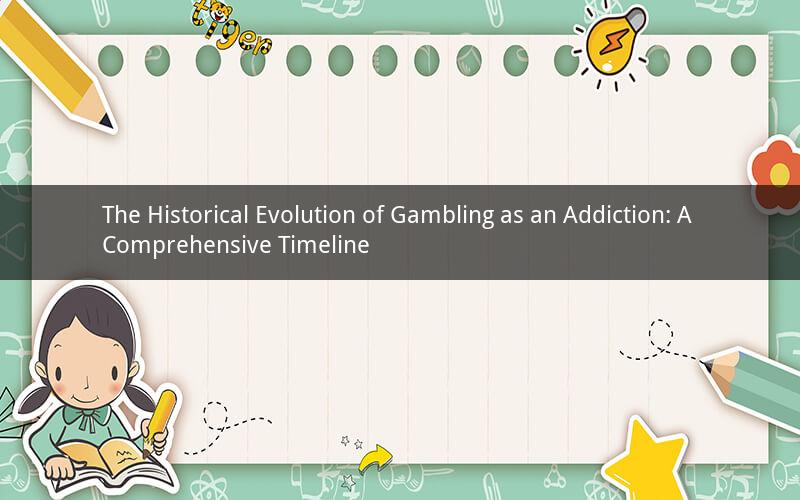
1. Introduction
The concept of gambling as an addiction has been a subject of debate and research for decades. Understanding when gambling was officially recognized as an addiction can provide valuable insights into its impact on individuals and society. This article delves into the historical evolution of gambling as an addiction, tracing its journey from a mere pastime to a recognized psychological disorder.
2. Ancient Origins of Gambling
Gambling has been present in various forms throughout history, dating back to ancient civilizations. From ancient Egypt to ancient China, gambling was a common activity among the elite. However, during this period, it was not considered an addiction but rather a social and entertainment activity.
3. The Rise of Gambling in the Middle Ages
During the Middle Ages, gambling became more widespread, not only among the wealthy but also the common people. It was often associated with festivals and fairs, providing a source of entertainment and income. Despite its growing popularity, the idea of gambling as an addiction had not yet emerged.
4. The Victorian Era: A Shift in Perception
The Victorian Era marked a significant shift in perception towards gambling. As society became more concerned with moral decay and the negative impact of gambling, the idea of it being an addiction began to take root. The era saw the rise of anti-gambling movements, aiming to curb the growing problem.
5. The Early 20th Century: Legalization and Regulation
The early 20th century witnessed the rise of organized crime and the illegal gambling industry. As a result, governments around the world started to regulate gambling, aiming to control its spread and minimize its negative impact. However, the concept of gambling as an addiction remained relatively unaddressed during this period.
6. The 1970s: The Birth of Problem Gambling Research
The 1970s marked a significant turning point in the recognition of gambling as an addiction. Dr. Robert C. Custer, a psychiatrist, conducted pioneering research on problem gambling, leading to the development of the first treatment program for gambling addicts. This research provided the foundation for further understanding and recognition of gambling as an addiction.
7. The 1980s: The DSM-III and Official Recognition
In 1980, the American Psychiatric Association (APA) published the third edition of the Diagnostic and Statistical Manual of Mental Disorders (DSM-III), which included gambling as a mental health disorder. This was a significant milestone in the official recognition of gambling as an addiction.
8. The 1990s: The DSM-IV and Expansion of Criteria
The fourth edition of the DSM, published in 1994, expanded the criteria for gambling disorder, providing a more comprehensive understanding of the condition. This edition also highlighted the potential for co-occurring disorders, such as depression and substance abuse, in individuals with gambling addiction.
9. The 21st Century: Advances in Research and Treatment
The 21st century has seen a significant increase in research on gambling addiction, leading to better treatment options and interventions. Advances in technology have also played a role in the development of online gambling, raising concerns about its potential for addiction. Researchers continue to explore the neurobiological and psychological factors contributing to gambling addiction.
10. Conclusion
Gambling has evolved from a mere pastime to a recognized mental health disorder. The journey from ancient civilizations to the present day has been marked by debates, research, and the gradual recognition of gambling as an addiction. Understanding this historical evolution can help us better address the challenges posed by gambling addiction and develop effective interventions.
Questions and Answers:
1. Q: When was gambling first recognized as a mental health disorder?
A: Gambling was first recognized as a mental health disorder in the DSM-III, published in 1980.
2. Q: How did the Victorian Era impact the perception of gambling?
A: The Victorian Era marked a shift in perception towards gambling, with increasing concerns about moral decay and the negative impact of gambling on individuals and society.
3. Q: What was the significance of Dr. Robert C. Custer's research on gambling addiction?
A: Dr. Robert C. Custer's research in the 1970s provided the foundation for understanding and treating gambling addiction, leading to the development of the first treatment program for gambling addicts.
4. Q: How has technology influenced the prevalence of gambling addiction?
A: The advent of online gambling has made it more accessible and convenient, potentially increasing the prevalence of gambling addiction. Technology has also enabled researchers to better understand the neurobiological and psychological factors contributing to addiction.
5. Q: What are some common treatment options for gambling addiction?
A: Treatment options for gambling addiction include cognitive-behavioral therapy, motivational interviewing, support groups, and medication for co-occurring disorders. The approach to treatment may vary depending on the individual's needs and preferences.